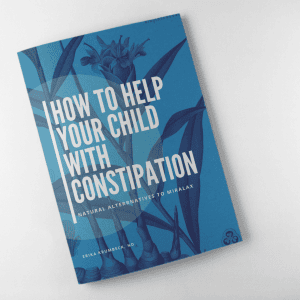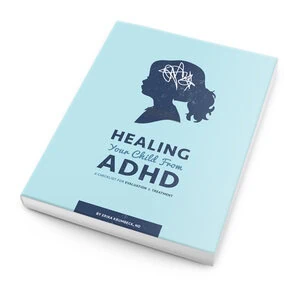Why do children need so much calcium? What do naturopathic doctors use calcium for?
Calcium is the most abundant mineral in the body. Approximately 99% of calcium is found in the bones and teeth with the remaining 1% in extracellular fluid like blood and soft tissues. Calcium is critical for many cellular processes, including regulating heart rhythms, nerve function, muscle contraction, blood clotting, and enzyme activation.1
Calcium is so important for physiological functions that the body has built in mechanisms to tightly control the amount of calcium in the blood and tissues. If calcium in the blood drops too low, the parathyroid hormone sends a signal to the bones to release more calcium into the bloodstream and the kidneys to release less in the urine. Once calcium in the bloodstream is restored, another hormone called calcitonin is released to tell the bones to stop releasing calcium and the kidneys to release more calcium in the urine. This process is carefully controlled by the endocrine system. Since low blood calcium stimulates the release of calcium from bone, it’s important to consume enough calcium to avoid weakening the skeletal system.
Food sources
Calcium is naturally found in dairy products such as yogurt, cheese, and milk while some beverages like plant-based milks and orange juice are calcium-fortified. Canned sardines and salmon with bones are a great source of calcium for individuals who don’t tolerate dairy products. Plant sources of calcium include leafy greens, bok choy, broccoli, cauliflower, almonds, edamame, tofu and beans.1 However, it is important to note that some vegetables contain high quantities of oxalic acid which binds to calcium and can inhibit its absorption. Consuming a variety of calcium rich foods can help offset the variability in bioavailability.
How much calcium do children need?
Calcium is one of the few minerals that children require more of than adults. The RDA for calcium steadily increases throughout the teenage years and reduces when bone growth slows in adulthood. The RDA for calcium is as follows:

What are the signs of calcium deficiency in children?
Calcium deficiency in children is known as rickets, although it’s more often a result of low vitamin D. If a child develops rickets, their cartilage fails to mineralize normally and can lead to irreversible skeletal abnormalities.
Prolonged calcium deficiency may also lead to osteomalacia (the softening of bones) and an inability for the child to obtain peak bone mass.1 Ultimately, this increases the risk of osteoporosis later in life.
Additional signs of a calcium deficiency include abnormal muscle contractions (cramps) and/or numbness and tingling in the hands and feet, abnormal heart rate, muscle weakness, constipation, and poor appetite2. These symptoms are critical to address with a medical provider since intermittent muscle contractions can progress to tetany, causing respiratory dysfunction. In adults, inadequate dietary calcium is associated with an increased risk of osteoporosis, colon cancer, diabetes, metabolic syndrome, and obesity.2
Children who are lactose intolerant or don’t tolerate dairy products are at an increased risk of calcium deficiency. Others who have conditions affecting fat absorption or various intestinal conditions have a higher risk of calcium deficiency due to a diminished capacity to absorb vitamin D (a fat soluble vitamin), negatively impacting the body’s ability to absorb calcium.2
Calcium absorption is limited by dietary fibers such as phytic and oxalic acid, excess intake of zinc and magnesium, and low vitamin D.1 Excess dietary sodium and protein increase urinary calcium losses and can also result in calcium deficiency. Another common cause of calcium deficiency is excess soda consumption. Soda has high amounts of phosphorus that decreases the absorption of calcium and sodas containing caffeine exacerbate the problem by increasing urinary excretion.1 Soda also displaces good sources of calcium from beverages like milk, fortified orange juice, or plant milks.
What are the signs of calcium toxicity?
Toxicity is quite rare in children and has not been associated with an over consumption of calcium found naturally in food.3 Over supplementation is possible and may be asymptomatic or accompanied by symptoms of appetite loss, nausea, vomiting, constipation, fatigue, frequent urination, hypertension, and abdominal pain.3 Severe calcium toxicity can result in delirium, coma, and death if left untreated.3
In the past, there have been concerns of excess calcium intake increasing the risk of developing kidney stones. There’s an important distinction to be made here! Excessive intake is not associated with an increased risk of kidney stones. Instead, increased kidney excretion or increased intestinal absorption may increase the risk of kidney stones.3
Calcium supplementation in children
Calcium is widely available in supplements, including in most multivitamin and multimineral products. There are many forms of supplemental calcium, including calcium citrate, sulfate, lactate, and carbonate. Calcium carbonate is often the cheapest but is associated with more gastrointestinal side effects.1 Calcium citrate is a good choice for individuals with low stomach acid (often older adults) and is best absorbed with food.1 The GI side effects of calcium supplements may be mitigated by trying a different form of calcium, taking it with food, or taking smaller amounts throughout the day.3 Calcium requires adequate vitamin D for proper absorption, so a supplement containing both may be necessary for some children.
Although the calcium requirements for children are quite high, supplementation is not always necessary. Children who avoid or don’t tolerate dairy may require a supplement with 200-500 mg of calcium a day, depending on their age and intake. The actual supplemental dose should be individualized and determined by your medical provider. I do not recommend doses higher than 500 mg of supplemental calcium per day, as studies show this is the limit to which the intestines can absorb non-food sources of calcium.
How to estimate if a child is getting enough calcium
In my practice I often tell parents that I am looking for approximately 3 servings of calcium-containing product per day. 1 serving is 1 “cup” of liquid milk (cow, sheep or goat milk) or fortified nut milk (hemp, flax, almond, coconut, oat or rice). 1 serving is also 1 “cup” of yogurt or cottage cheese. Cheese typically counts as a 1/2 serving, mostly because we do not typically consume 1 full cup of cheese at a time, but rather a few slices or cubes at a time.
1 “cup” is about 3-4 ounces for toddlers (1/3 of a measuring cup), 4-6 oz for children ages 4-8 (1/2 of a measuring cup), and 6-8 oz for children ages 9-18 (about 3/4 – 1 measuring cup).
Families can substitute sardines or canned salmon with bones for 1 “cup” of milk. However, I advise parents to not rely on having children eat more greens as a primary source of calcium, as it typically takes more than 24 cups of raw broccoli to reach the equivalent of 3 servings of milk. Of course, I highly advise parents to continue having their children eat sources of fresh greens like broccoli or kale, as they are highly nutritious and a great source of folate and other vitamins. I just do not advise parents to rely on greens as a primary calcium source.
Families should aim for around 3 servings, but not significantly more than 3 servings, as excess cow’s milk intake does increase the risk of iron deficiency in children, see below.
For a full list of calcium-containing foods please see our Calcium Containing Foods Handout on the Physician Resource page.
Please be aware that cow’s dairy intolerance and/or cow’s dairy allergy is extremely common. Cow’s dairy may not be the best source of calcium for children with gastrointestinal issues (irritable bowel syndrome, constipation, SIBO), or children with ADHD or autism. Our next article will detail the differences between intolerance, allergy, and even why cerebral folate deficiency in ASD may be linked to cow’s dairy consumption.
Is calcium supplementation safe for children?
Inappropriate calcium supplementation can lead to negative health outcomes. In adults, excess calcium can increase the risk of coronary artery disease, but the same is not true in children. Children have much higher calcium requirements than adults and over-consuming calcium rich foods is unlikely to cause calcium toxicity. The caveat here is that too much calcium competes with the mineral iron and can lead to iron deficiency anemia. Typically, this is only a problem in children who drink a lot of milk. To avoid iron deficiency anemia, limit milk consumption to 16 ounces a day in children under the age of five.3
-
 My Health Binder For Kids (Printable E-book)$18.00
My Health Binder For Kids (Printable E-book)$18.00 - Product on sale
 How to Help Your Child with Constipation – Natural Alternatives to Miralax (E-book)Original price was: $25.00.$15.00Current price is: $15.00.
How to Help Your Child with Constipation – Natural Alternatives to Miralax (E-book)Original price was: $25.00.$15.00Current price is: $15.00. - Product on sale
 Healing your child from ADHD (E-Book)Original price was: $25.00.$15.00Current price is: $15.00.
Healing your child from ADHD (E-Book)Original price was: $25.00.$15.00Current price is: $15.00.
Clinical uses of calcium in naturopathic pediatrics
Bone Growth
It is well established that adequate calcium intake is imperative for proper bone growth and development since maximum cartilage mineralization and peak bone mass depends on sufficient calcium intake. Children who develop strong bones early in life decrease their risk of developing osteoporosis as older adults.1 In the meantime, they decrease their risk of fractures and bone stress injuries. Consuming a wide variety of calcium rich foods and obtaining adequate vitamin D is essential for bone growth in children. Children who are unable to consume enough calcium and vitamin D for various reasons should consider a supplement. Regular physical activity and a reduction in soda can also support healthy bones!
PMS in adolescents
Premenstrual syndrome (PMS) is a disorder that affects millions of women days to weeks before menses and is associated with emotional, behavioral, and physical symptoms.4 Common symptoms include “abdominal bloating, breast tenderness, anxiety, crying spells, depression, fatigue, lack of energy, anger and irritability, changes in appetite, and varying degrees of edema.”4 In a double-blind randomized clinical trial, researchers found that supplementing with 500 mg of calcium for two cycles resulted in a reduction in PMS symptoms during the intervention and two menstrual cycles after intervention.4
Growing pains
Mild bone and muscle pain is common in children while they’re rapidly growing and developing. Transient, double sided leg pain is commonly referred to as “growing pains” in children and nutrient deficiencies may be contributing factors. Muscle cramps and minor bone pains are all symptoms of calcium, vitamin D, and magnesium deficiencies. Many studies show a clear correlation between vitamin D deficiency and growing pains, while studies on calcium and magnesium remain inconclusive.5 However, anecdotal evidence suggests a 2:1 calcium:magnesium ratio as beneficial in children with growing pains. In my practice I find that supplementing calcium:magnesium with at least 250 mg of calcium daily reduces growing pains in nearly all children. Children with leg pain that does not respond to calcium:magnesium supplementation may need additional orthopedic workups. Additionally, increasing whole food sources of calcium, magnesium, and vitamin D may improve symptoms of growing pains in children.
Lead toxicity
Chronic exposure to lead, even in small quantities, is associated with lead toxicity in children, resulting in developmental and behavioral delays, learning disabilities, and lower IQs.3 Lead used in everyday products like cans, gasoline, and paint has been discontinued in the United States, but may still pose a risk to children living in urban areas.3 Some studies indicate adequate calcium intake as protective against lead toxicity by decreasing the absorption of lead and preventing lead mobilization from the bones during bone demineralization.3 This is important since lead can be stored in the bones for more than 20 years! Furthermore, a study on pregnant women found supplemental calcium during pregnancy significantly decreased blood lead concentrations in the mother.3 Lead is easily transported across the placenta and can expose the baby to dangerous amounts of lead, making calcium an important consideration during pregnancy.
Summary of the importance of calcium in children
Calcium is a mineral that plays a role in numerous cellular processes, including bone health, regulating heart rhythms, nerve function, muscle contraction, blood clotting, and enzyme activation. It can be found in a variety of foods such as dairy products, fish, leafy green vegetables, almonds, and legumes. Children require more calcium than adults and underconsumption may lead to muscle tingling, numbness or weakness, constipation, osteomalacia, and rickets. Excess calcium supplementation can become dangerous and should be determined by a qualified medical provider. Calcium absorption is limited by dietary fiber, excess zinc, magnesium, sodium or protein, large amounts of soda and is increased with adequate vitamin D. In a clinical setting, calcium is useful for supporting bone growth in children, preventing osteoporosis later in life, reducing PMS and growing pain symptoms, and reducing the effects of chronic lead exposure.
References
- Gropper S, Smith J, Carr T. Advanced Nutrition and Human Metabolism: Seventh Addition. Cengage Learning. 2018:455-460.
- National Institutes of Health. Vitamin B6. NIH. 2022.
- Higdon J. Calcium. Linus Pauling Institute. 2022.
- Shobeiri F, Araste FE, Ebrahimi R, Jenabi E, Nazari M. Effect of calcium on premenstrual syndrome: A
double-blind randomized clinical trial. Obstet Gynecol Sci. 2017;60(1):100-105.
doi:10.5468/ogs.2017.60.1.100 - Insaf A. Growing Pains in Children and Vitamin D Deficiency, the Role of Vitamin D Treatment for
Resolution of Symptoms. Journal of Health, Medicine and Nursing. 2017;39.

